Bob Ross Materials – The Joy of Painting wet-on-wet
>SHOP FOR BOB ROSS ART MATERIALS HERE
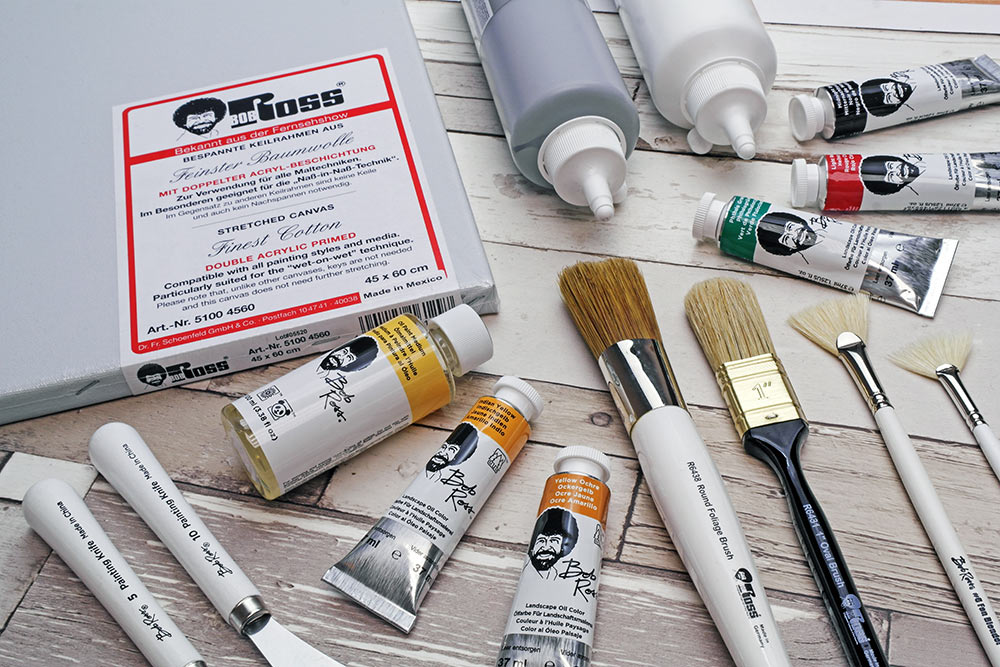
You may have never heard of Bob Ross when he was alive, but now, 25 years after his death, he is becoming a household name. With his affable character, soft voice and his happy little accidents, Bob Ross has become a lock down sensation! People are tuning in and picking up a paint brush – often for the first time! Read on to find out more about Bob Ross art materials, and how to get started painting in Bob’s famous style.
Who is Bob Ross?
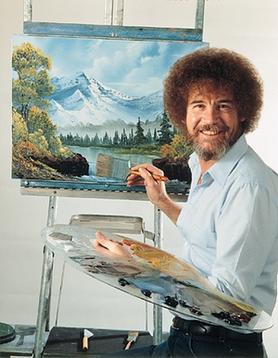
Born in Florida in 1942, Bob Ross didn’t discover oil painting until he started taking art lessons whilst serving in the U.S Air Force. He studied the ‘wet-on-wet’ technique and became ‘hooked’.
After leaving the Airforce, he continued to study at various art schools, perfecting his ‘wet-on-wet’ technique and even teaching it to several of his friends and colleagues.
In 1983 Bob Ross’s televised lessons, ‘The Joy of Painting’ premiered. Where it attracted millions of viewers during the decade that it ran. The appeal of the show was not only Bob’s humour and lovable persona, but also the fact that watching him complete a full painting in just 30 minutes gave people the inspiration to give it a go themselves.
The Joy of Painting TV series was so successful, it was carried by over 275 television stations. Bob Ross Inc produced videos, books and all the materials required to paint along with Bob as well as certifying instructors to teach people to paint in Bob’s style. Sadly, not long after his original TV shows stopped airing, Bob passed away from Lymphoma at the age of 52.
Now, decades after his death, the Joy of Painting series can now be found on Netflix, YouTube, Amazon Prime and even the BBC making Bob Ross more watched than ever!
What is the ‘Wet-on-Wet’ Technique?
The wet-on-wet technique in oil painting, also known as ‘alla prima’ is where you apply a new layer of oil paint, on top of a still-wet layer rather than waiting for a layer to dry before applying the next. This method allows you to complete a whole painting very quickly – which is a big part of the appeal to people watching Bob’s shows.
Where can I watch Bob Ross?
If you are in the UK and have a TV licence, you can visit BBC iPlayer and watch the first 2 series of The Joy of Painting.
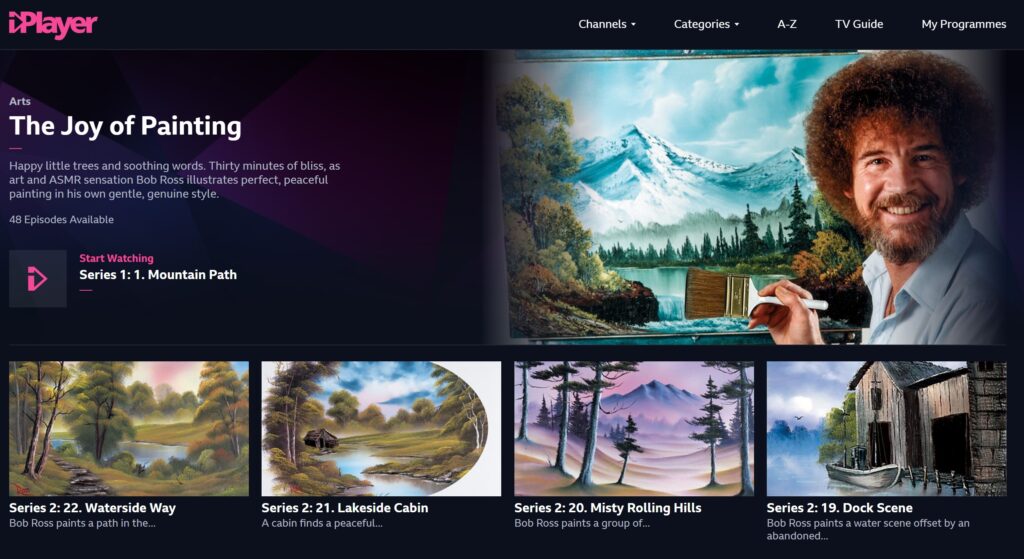
Alternatively, you can catch up on Amazon Prime video or if you are in the US – the Bob Ross YouTube channel has every episode free to watch there. Unfortunately, that content is not available in the UK.
What Materials do I need to follow Bob Ross’s Technique?
You can follow Bob Ross’s technique using any oil paints, we have been told by customers that our Ken Bromley Oil Paints have a similar consistency to the thicker Bob Ross oil paints. Many people also use Daler Rowney Georgian Oils, or Winsor & Newton Winton. If you want to follow Bob’s technique using Water Mixable Oil Paint, this is also possible using any water mixable oils. Just make sure you make your own liquid base coat and don’t use the official Bob Ross brushes which can not get into contact with water.
Bob Ross Inc. also produce a whole range of materials to Bob’s original specification which you can use to follow his demonstrations.
We have listed out the main materials he uses for his Landscape series – including a useful recipe to make your own liquid base coats! We have also included a helpful video made by certified instructor Sophia Flowers where she talks us through her recommended equipment for starting out.
Base Coats
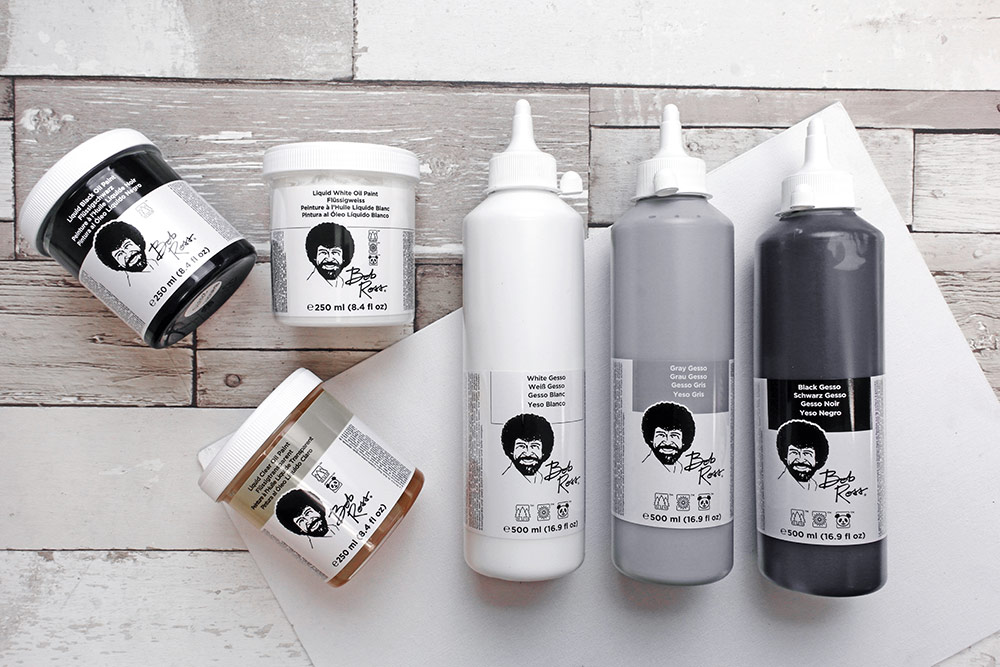
There are two types of base coats in the Bob Ross range, the liquid base coats which are essential for the wet-on-wet technique, and the gessos which you can use under the liquid clear.
Liquid Base Coat
Essential for the Bob Ross wet-on-wet technique. The first step to the painting process is to coat the canvas in a liquid base coat which allows the paint to be blended directly on the canvas rather than on the palette. It can also be used to thin other colours. Available in white, black, clear and opal. The whole idea that a thin paint will stick to a thick paint is the basis behind the whole technique.
Helpful hint ~
You can make your own Bob Ross liquid base coats. Below are recipes using Winsor & Newton products. This can be especially useful it you would like to try using the wet-on-wet technique using water mixable oils – you can make your own ‘water mixable liquid white’ using the Artisan recipe.
Liquid Clear——Stand Oil 4 parts to Sansodor one part.
Liquid White—– Winton or Artists Titanium White at 1 part to 4 parts of the Liquid Clear mix.
Water Mixable
Artisan Liquid Clear 4 parts Artisan stand oil to 1 part Artisan thinner.
Artisan Liquid White—1 part Artisan Titanium White with 4 parts of Liquid clear mix.
If too thin, add more white –too thick, add more thinner.
___________________________________________________________________
REMEMBER – if you are using water mixable oils you can not use the Bob Ross brushes, the Bob Ross brushes must be cleaned with odourless thinner and can not come into contact with water.
Bob Ross Gesso
The Bob Ross Gesso is available in white, black and grey and is used as a primer and undercoat for the canvas before you begin painting. You can use the black gesso under the Liquid clear to create some interesting effects.
Odourless Thinner
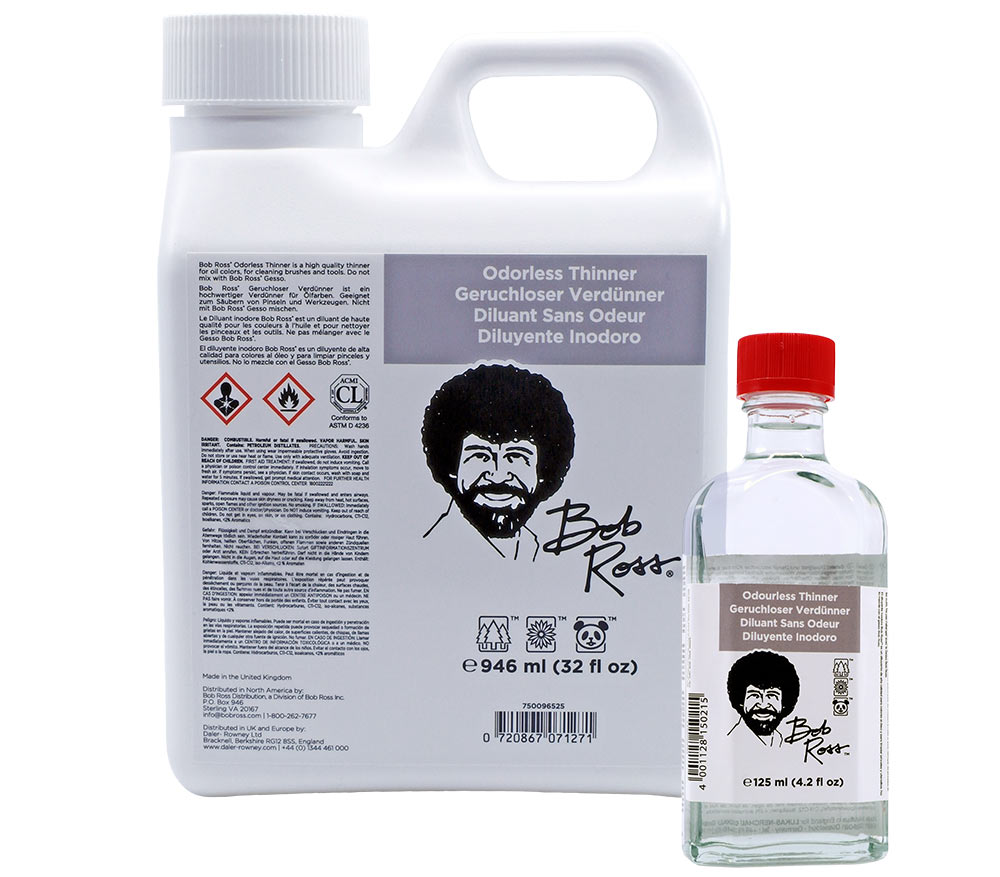
Bob Ross’s odourless thinner is another essential. You can use any other type or artists’ paint thinner, but this one is so popular because it is odourless. Fill a bucket with the thinner to clean your brushes. Allow the sediment to settle for a few days and it is ready to be used again!
Other odourless/low odour thinners include Loxley Low Odour White Spirit and Winsor & Newton Sansodor.
Paints
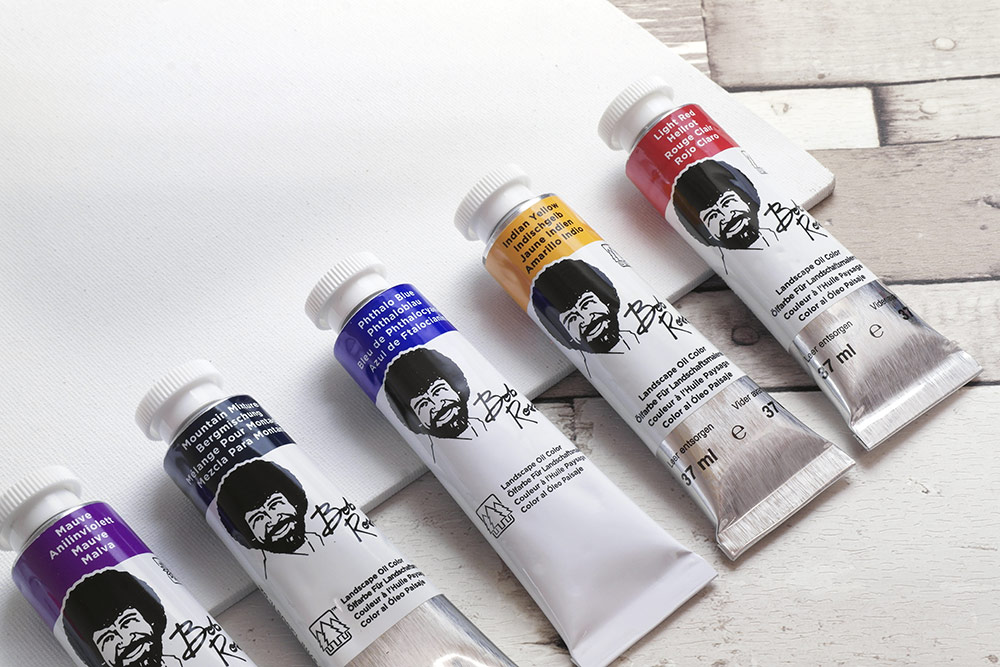
Bob Ross paints are available in two sizes, 37ml and 200ml. There are 14 colours in the Landscape range, allowing for endless natural combinations. The paint is a smooth yet firm consistency which makes it perfect for the wet-on-wet technique.
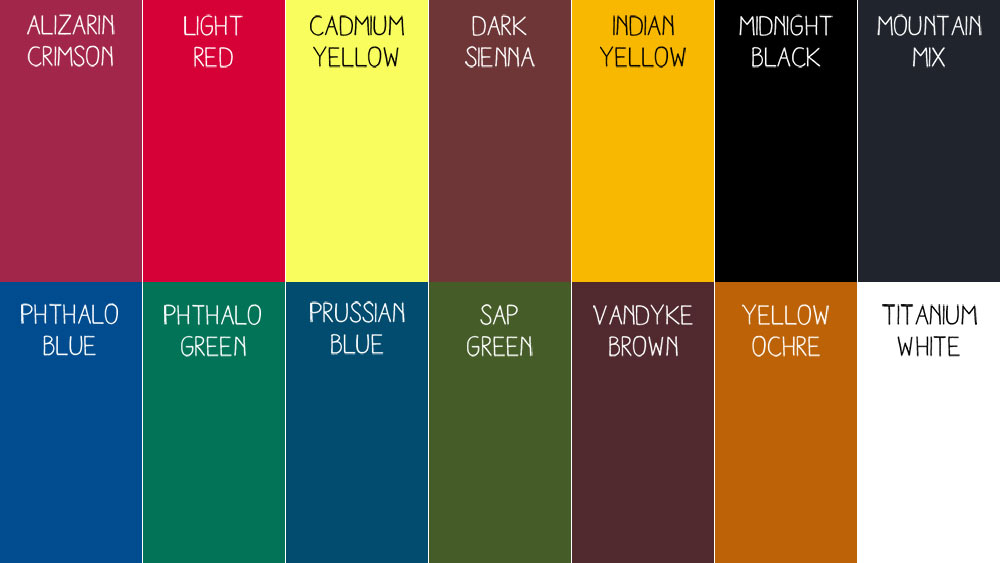
Alizarian Crimson
This is a very versatile colour in the Landscape range. Used to create purple and lavender shades when mixed and also for underpainting in dark mountain mixtures.
Light Red
This is a powerful colour and also the colour Bob used for signing all his paintings. When mixed with yellows it can be used to add highlights often found in the foreground bushes in Bob’s paintings.
Cadmium Yellow
Out of the three yellows in the range, Cadmium Yellow is the brightest. Used for the brilliant sunlight in the sky as well as to highlight green areas when mixed with Sap Green.
Dark Sienna
Of the two browns in the Landscape range, this is the lighter. Mixed in a marbled mixture with Titanium white, Bob often uses it to create highlights on the cabins and the trees.
Indian Yellow
Another of the three yellows in the Landscape range, Indian yellow is often used to paint the sun in the sky. It can also be used to vary the colour of the highlights on trees, bushes and grass.
Midnight Black
Used alone as a base colour for simple shapes of the trees and bushes. It can also be mixed with the Titanium white in different ratios to create a selection of different greys.
Mountain Mixture
Not only used for mountains, as the name suggests, it is used to underpaint other objects such as trees, bushes and ground areas.
Phthalo Blue
A strong blue colour which is most often used for skies and water – but also excellent for snowy highlights.
Phthalo Green
This green is almost a fluorescent colour. Because of its transparent qualities, it can be used on top of black gesso creating beautiful effects, such as those found in Bob’s Northern Lights paintings.
Prussian Blue
Darker than the Phthalo blue, it is often used in the cold winter skies in Bob’s paintings. It can also be used to darken the corners of a Phthalo Blue sky to create a vignette effect.
Sap Green
The main colour used for all foliage. When mixed with the yellows and the bright red it can be used for wonderful highlights on the for all things green as well.
Titanium White
Use alone for highlights, clouds, snow or mixed with other colours to create a variety of shades.
Van Dyke Brown
This is the darker of the two browns in the Bob Ross Landscape range. Used for underpainting large trees and cabins and a ‘go to’ colour for all dark base coats.
Yellow Ochre
A beautiful soft hue, just right for making the highlights on foliage, it is the darkest of the three yellows in the Landscape range. Mixed with the sap green, or one of the other yellow, it can be used to add interest to the foliage.
Brushes & Knives
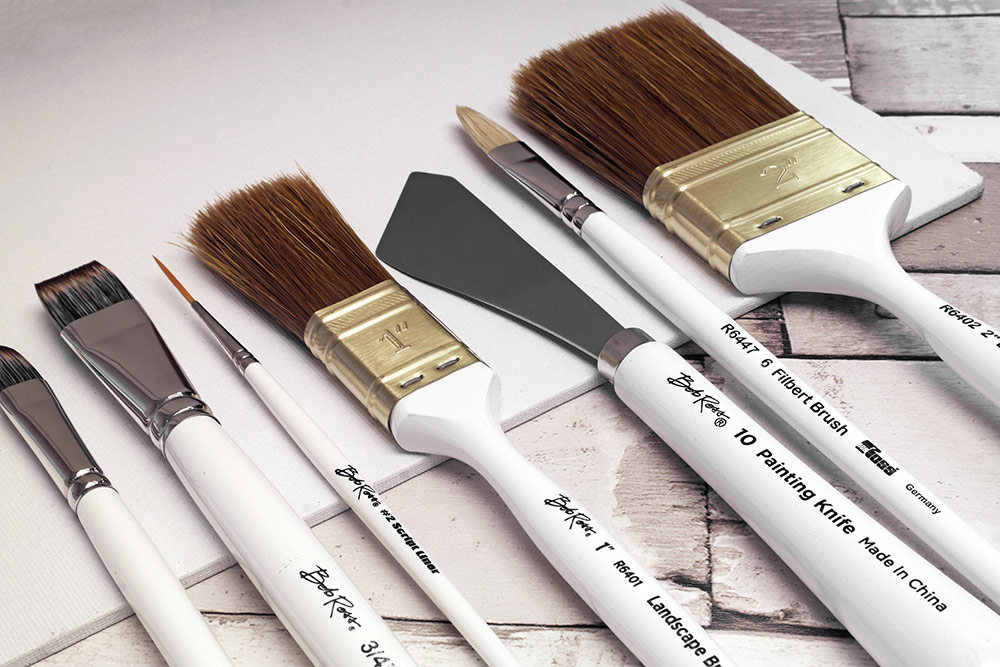
The whole range of Bob Ross Landscape brushes are made to Bob’s specifications. All made from natural bristle perfect for the wet-on-wet technique. Just remember, these brushes can not be cleaned with water, you must always use a solvent such as the Bob Ross Odourless Thinner.
Whilst there are no direct replacements for some of the Bob Ross brushes, we do have a selection of alternative oil painting brushes on our website which would be suitable for painting in Bob’s style. If you are using water mixable oils, it is advisable to go for a synthetic hair.
1” Landscape Brush
One of the four large brushes in the Landscape range and probably the most commonly used. Used in the application of the liquid base coat as well as for painting skies, clouds, water, mountains and many other elements of Bob’s iconic landscapes.

2” Background Brush
Can do all the same things as the 1” brush, but it’s larger size allows you to do all of the above at a much faster speed!

1” Round Foliage Brush
Another one of the four large brushes in the range, this brush is not just for foliage, but also great for clouds, trees, bushes and foothills.

2” Soft Blender Brush
This blender brush allows you to create the soft delicate areas in the landscape and seascapes. Wispy clouds in the sky, mist at the base of mountains, the crest of a wave and spray from waterfalls.
Half Size Round Brush
This brush is perfect for creating wonderful shapes for trees, bushes and other foliage.
1” Oval Brush
The 1” Oval is primarily used for evergreen trees and highlights.

#3 and #6 Fan Blender Brushes
Two different sizes used to create a plethora of things. Grass, hills, clouds, mountains, boats and many other beautiful effects. The #3 does just the same as the #6, but just smaller!

#2 Script Liner Brush
Perfect for details, fine grasses etc this is a special brush made from natural bristles.

#6 Bristle Filbert Brush
Used a lot for Bob’s seascapes, as well as for tree trunks and other small details.

Painting Knives #5 and #10
These straight edged knives are unique to Bob Ross and are larger and firmer than other painting knives.
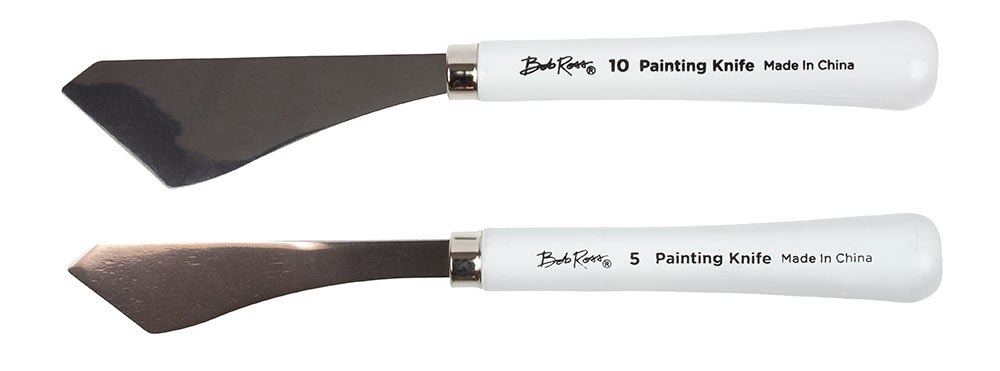
Sophia Flowers Introduction to Bob Ross Materials
Watch the video below to see certified instructor Sophia Flowers take us through her recommended basic set up for getting started with Bob Ross materials.
Visit our website to find the full selection of Bob Ross materials and get started on your Bob Ross painting!
What happened to All Bob’s Paintings?
For every episode of the Joy of Painting, Bob painted 3 versions of the artwork. One before the episode to be used as a visual reference, the one he actually completes during the show and a third to be used for his books. This means there are literally hundreds of Bob Ross Paintings in existence, but apart from a few that are now displayed in the Smithsonian National Museum of American History, the rest are simply in storage. See the short film below to see the story of Bob’s paintings.
Sources:

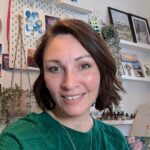
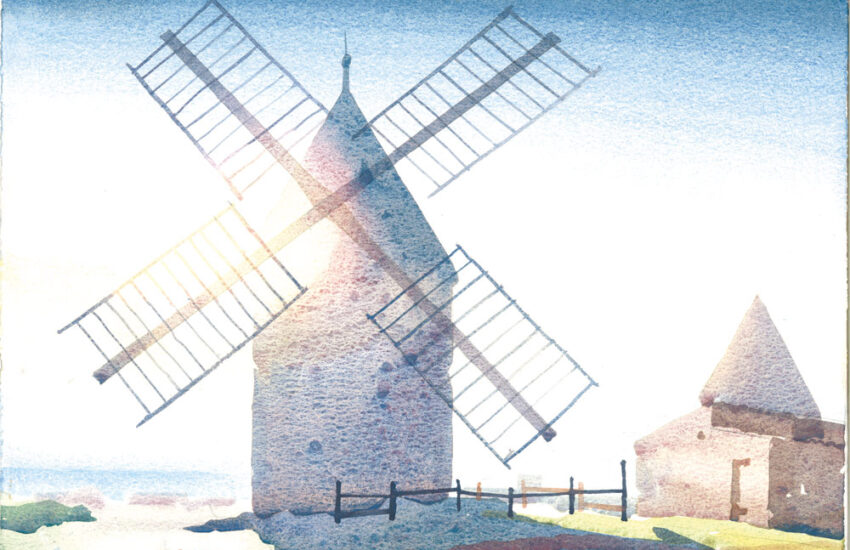
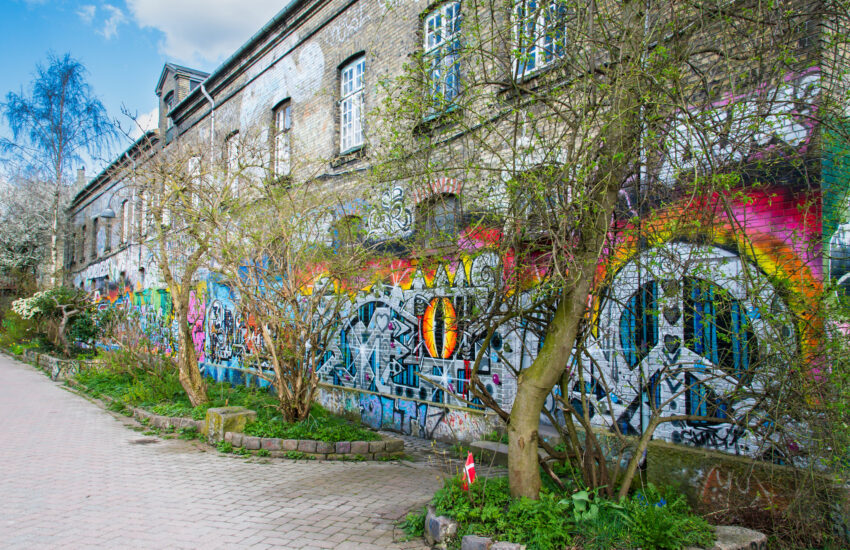
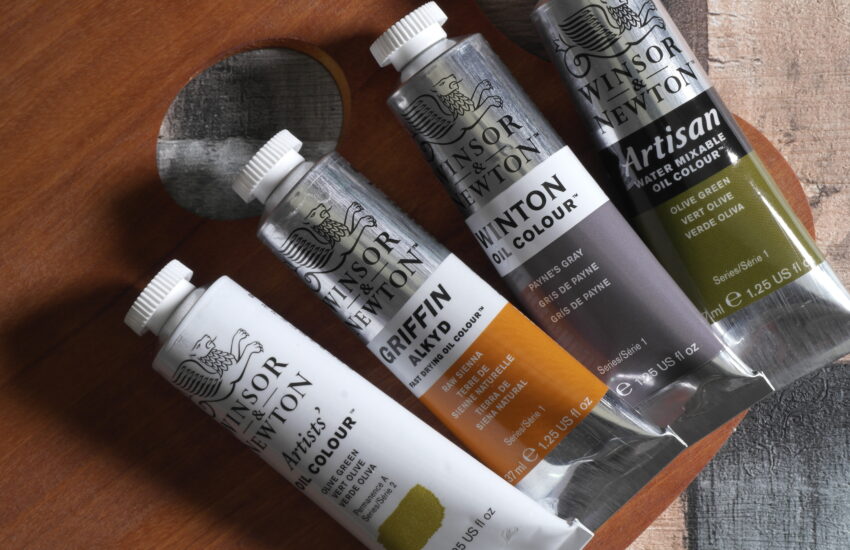
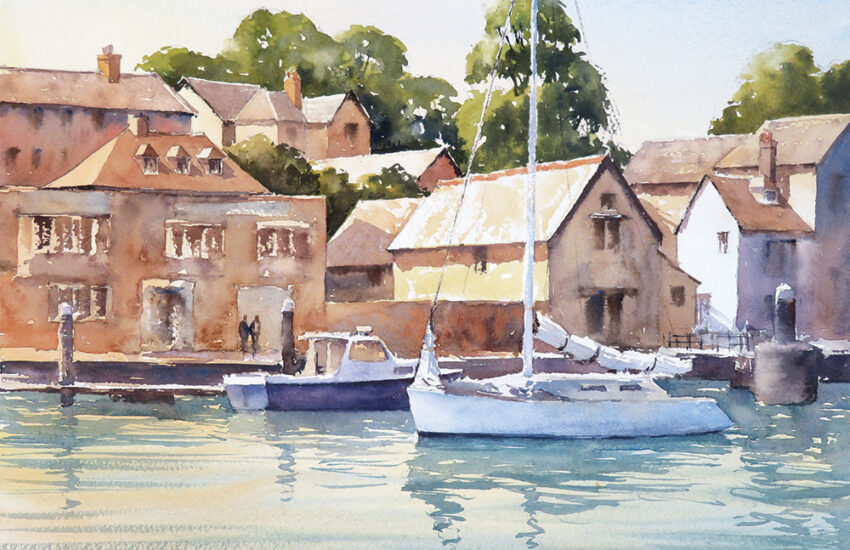


Hi there
I am Albie Hunzeker and your site is as good as any of the other sites I’ve seen. If I could make a suggestion when I clicked on any of the products you’ve got listed, I simply get redirected to a different page but the product looks exactly the same? I usually do that in order to hopefully view what’s included in ( I don’t know) whatever it is I wandered up to. Sometimes it does show me what all’s included and sometimes not and I’m sorry to say but it’s usually why I clicked on it to begin with. Asides from that your site’s as good as any of the other ones I’ve visited, oh yeah I had to keep asking it to show me twenty more products (????)
Sincerely
Albie Hunzeker
PS now it’s saying I’ve already said that, but tonight’s the first and possibly the last time I’ll say anything on this website ( I can promise that).
Hi Albie. Thank you for your feedback! We’re sorry to hear about the trouble you’ve encountered on our site. Could you please send us more details or screenshots to [email protected]? We’d be happy to investigate further and assist you.
Would like to know if you have a pallet knife for lefties. Everything is always geared for right handed people-
Hi Kathy. Thanks for your comment. Unfortunately none of our palette knives are marketed as being specifically for left-handed artists, but you should be able to use them in either hand. Is there a specific size or shape that you’re having trouble using?
I found an easy way to open stuck on tube tops is to pour a little boiling hot water over the cap. Then open with a cloth in the hand to avoid any heating. Works every time for me.
I’m almost 86 and anxious to get back into painting – BUT ,my Bob Ross tube oils are hard to pen but still full – is there a way to soften up and caps and perhaps use my older oils? I have introduced many people to his wonderful U-tube lessons!! Wish e luck!
I am confused. I recently heard about white and black gesso paint. Did Bob Ross every use this paint. All I heard from Bob is that he would first use liquid white or clear white on the canvas before proceeding with the painting. Did not hear about gesso paint. What do I use to prepare each canvas? Thanks.
Terry
Hi Terry. Gesso is a quick drying, acrylic based primer that is used to prepare canvases prior to painting so they are ready to receive your colours – it sits as a layer between the canvas and your oil paint. Liquid White/Clear on the other hand is a fluid oil paint that forms the slow-drying base layer fundamental to the wet-in-wet painting technique. You don’t use one in place of the other as they both perform different jobs. All our pre-stretched canvas, including Bob Ross Canvas, come pre-primed with an acrylic gesso – so if you are working on these you won’t need any additional gesso layers. If you are working on an unprimed surface then you would use Gesso to prime the surface. If you are working on a pre-primed canvas then you could add additional layers of Gesso if you wanted to work on a tinted background (like black or grey for example).
Thanks for the info I needed on Liquid clear and Liquid white. Have heard Ross talking of it and had no idea what it was. My question now is, is Liquid clear available ready mixed? as most art shops near me don’t stock it.
Hi Chris, we stock liquid clear on our website along with the other Liquid Base Coats.
What do you use to stick on the contact paper that you put on the canvas
Hi Margaret. Contact papers usually have one side covered in a low tack adhesive strong enough to stick to your canvas, but not too strong that it would damage the surface. They should work similarly to our Frisk Film.
I badly need to learn more about everything. I am an artist, that knows nothing about anything to do with art. I paint all the time, but dont hav3 a clue about wet on wet, how to mix colours etc. So maybe you could help. I also hate computers. I write with beaitiful itaalic hand writing but that cant get used much these days. Infact the modern worldoesnt suit me that much. Im not complaining but just my truth.
Hopefully you can learn something from our blog Mary, and if you ever need any advice you can always give us a call and speak to one of our friendly customer service team. Most of them are artists and are always happy to help and advise!
What a wonderful video and comments on starting out with the Bob Ross materials etc.
I am an artist but I have never used his products at all, I will have a go with them.
I never got chance to see his series while he was alive, due to the fact that I was at work, and now I’m retired
I’m watching his TV series on BBC4.
Sadly he was too young to pass away at 52, in 1992 if I’ve got the year right.
Is it possible to paint over parts of a dried painting that I did last year with Bob Ross wet-on-wet technique? I have some changes I would like to make to the sky. I have his paints, gel, gesso, brushes, etc. just want to repaint parts of the sky in my painting if possible. What steps would I need to take with his products or otherwise?
Hi Verna. I’ve just checked with our supplier and you should be fine using Bob Ross products to paint over areas in your painting – you’d just need to apply the base coat to the areas you want to rework and then add the paint in. We’d recommend checking that the oil painting is completely dry first (if you gently scrape it with a blade the paint should come off as a dust, rather than a roll) and that is is clean. Hope this helps.
Hi, What brushes do you recommend for oil mixable paint so I can get the Bob Ross look? I’ve read on your website that I can’t use Bob’s brushes with water. Thanks, ps, thanks for tips on making liquid white etc.
Hi Theresa. The types of brushes we’d recommend would depend on how you are using the water mixable oils. If you are cleaning your brushes with water, but extending your paints with water mixable thinners, oils and mediums then you should be fine using hog bristle alternatives. For the flat landscape brushes we’d usually recommend either the Omega 1031N or Series 22 Varnish Brush. You can also swap out the fan brushes for a Series E Hog Fan. A filbert brush is available in most of our hog brush ranges, and a script liner can be replaced with a rigger. Unfortunately some of the other brush shapes are more difficult to source alternatives for.
If you are using water to thin your colours, rather than just for cleaning, you’ll probably find that hog hair goes a bit soggy and limp. In this case you’d be best opting for synthetic alternatives – like our new Bristlene range or the Artisan range. We do stock large flat synthetic brushes – like the System 3 Skyflow and the largest Polar brushes – but they are considerably softer than a hog hair brush.
Thank you, I’ll take a look at these brushes on your site.
Bob Ross was a God,s gift to us all. God put him on this earth to show us the joy of painting,. With his painting of style, he introduced u s to be wit h nature. We have never seen such a beauty that exist . Uless , you actually been to tghose places, like Alska. I t is a God’s paradise. Thank you Ross.
I intend to try the full range in the near future.
Bob Ross left a legacy that would be beyond his belief. Well deserved. I have often advised client to try his products as I know have much they will enjoy his videos.
What a great opportunity this Christmas 2020 to see some of Bob’s episodes again after so many years and ones I haven’t seen before . He was a total Genius and has inspired me to take my charcoal and pencil drawings to his oil painting techniques.
The people’s Painter Lost to early !!!
Rob Pask
Bob Ross – a genius and a hero! Who could resist his ‘happy little a accidents’, trees, bushes, clouds, mountains, etc. It is a privilege to watch him conjour up the visual delights that spring from his brush and his incredible artistry. An object lesson in how to leave a lasting legacy for others to enjoy and learn from.
Sadly, a legacy ruined by BR Inc and the way they ripped him and his family and friends off. Avoid BRI at all costs.
My wife Vicki age 44 has just started her 6 months of chemo and after watching a couple of Bobs episodes we thought what a great way to do something exciting and relaxing together and also would occupy her when she needs to try and forget what shes going through, its something that we wouldnt of ever of thought of doing or even trying but with Bobs easy to follow instructions and encouraging comments it will help us massively on her recovery process , no mistakes just happy accidents x
RIP Bob
I am 80 years old and the Bob Ross technique is to say the least is the most exciting art form l have ever seen. Please if possible send me the info on how to start this process where to source your material and cost. How to order. There is no limit on how much i can learn. Note I live in south Australia.
Hi Anne, we sell everything you need to paint in the Bob Ross style. Unfortunately, due to COVID disruptions, we are not currently shipping to Australia, although we hope to resume soon.